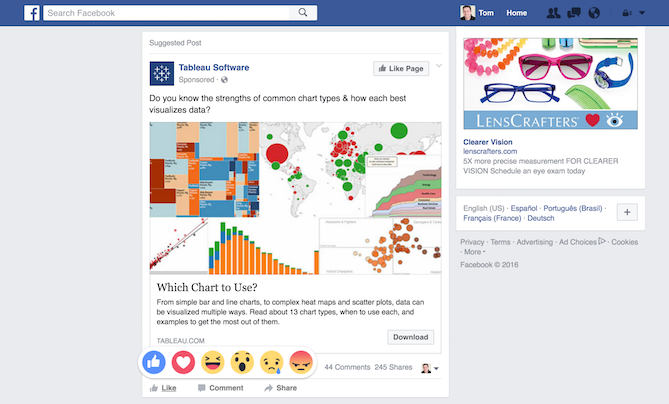Which Of The Following Represents A Change In The Technological Environment Of A Marketing Firm?
Imagine someone arrives at your website, Facebook Page, or advertizement. At present, imagine that you could alter your marketing dynamically, right at that place on the spot, in response to their emotional reactions. It would exist nothing short of a game changer for your business, right? Notwithstanding this is not fantasy. Exploding with investment and technological advances, the world of emotion detection and recognition technology will change the face of marketing in the years to come up. Emotions are what bulldoze your audition to purchase. In fact, studies by the neuroscientist Antonio Damasio found that people with damage to the role of the brain that triggers emotions -- in other words, people that are unable to experience emotions -- find information technology extremely hard to brand decisions. The lesson? If your marketing is not evoking an emotional response from your target audience, you are making it extremely hard for your prospective customers to purchase from you. That's right, your ain marketing is potentially causing prospects to turn away from you and your brand. What's a marketer to exercise? Permit's dive into some inquiry. Many of the most successful marketing campaigns and initiatives are focused on emotions. Take Dove's "Real Dazzler" entrada, which was an attempt to change the conversation effectually women'south dazzler. Or Nike's "Just Practise It" campaign, firing upward the inner-athlete in everyone. Or MasterCard's "Priceless" campaign, which has been powering brand success for a whopping 19+ years. All of this marketing aims to move your heart, and and then relies on the experience to build a lasting bond with the brand. What it doesn't practise is rely on feature sets, discounts, or new technology to move you to a sale. None of it speaks to the number of offices, employees, or years in business of the brand.Google Senior VP of Global Marketing,Lorraine Twohill, states, "If we don't make you cry, nosotros fail. It's about emotion." Twohill is not alone with this sentiment. Multiple studies point to emotional marketing as more than effective than other forms of marketing (east.g., production-focused marketing). Based on an assay of 1,400 successful advertizement campaigns, the book Brand Immortality past Hamish Pringle and Peter Field reveals that advertising campaigns focused on emotional content performed approximately twice likewise (31% vs. 16%) as those with only rational content. The power of emotional content should not come as a surprise. Afterwards all, emotions drive us to action. As consumers, we first decide on a purchase based on emotion, and then try to justify it through the more than rational parts of our brain. Longer-term, emotions are what crusade people to adopt brand names, even if generic alternatives are available. Findings from a 2015 Nielsen Consumer Neuroscience study of 100 ads across 25 brands in the consumer goods market revealed that ads with the all-time emotional response generated a 23% elevator in sales, meaning that emotional marketing is non merely constructive as an engagement vehicle but as well as a true business driver. And don't recall that emotion-based marketing is applicable to only B2C marketing and individual consumers. Business organization buyers are also creatures of emotion. In fact, successful B2B companies like GE, Cisco, IBM, AutoDesk, and Qualcomm all focus on emotions in their marketing. Similar to the Pringle and Field findings, the research report "From Promotion to Emotion: Connecting B2B Customers to Brands" past CES and Google explains that B2B brands attain roughly twice the bear on with a target audience when appealing to the personal value to the buyer including emotional benefits. In consideration of the power of emotional marketing, it should be no surprise that the emotion detection and recognition market place is projected to be worth $22.65 Billion by 2020, according to the market research firm MarketsandMarkets. Equally a result, investment in the space is exploding. Apple, ane of the most valuable companies on the planet, has been keenly interested in emotion recognition for years. In 2014 the company filed a patent that described software for analyzing and identifying a person's mood based on a multifariousness of signals, including facial expression. Earlier this yr, Apple acquired Emotient, an emotion-recognition technology visitor. Emotient has a patent for a method of collecting and labeling up to 100,000 facial images a day, supporting a figurer's ability to recognize facial expressions. It's reasonable to believe that Emotient'southward emotion recognition applied science will start appearing in iPhones and iPads before you know information technology, and then possibly used every bit a platform for more targeted and dynamic engagement when users are in their browsers. Last twelvemonth the consumer-research company Nielsen bought Innerscope, which uses biometrics such as encephalon scans and galvanic skin response (GSR) to mensurate subconscious emotional responses to media and marketing. Affectiva, an emotion recognition technology developer, raised $14 million just a few months ago. Affectiva boasts the world'south largest emotion data repository, with 40 billion information points and close to four one thousand thousand faces analyzed using its engineering science. Overall, those using emotion analysis to exam audience reaction to their marketing include major marketers such as Unilever, P&K, Mars, Honda, Kellogg, and Coca Cola. For instance, Kellogg'due south used Affectiva's software to determine its ads for Crunchy Nut cereal, with the goal of generating high engagement rates with the audience. Viewers were shown multiple versions of a commercial featuring animals. A version of the advertizement featuring a snake produced the most laughs, merely low date rates when viewing the advertising a second time. The facial recognition software revealed that an culling version of the advertising featuring an conflicting produced the desired engagement levels. Kellogg's therefore decided to rollout the alien-based ad instead, helping to drive the cereal's sales. Being able to adjust 1's marketing dynamically, based on the real-time reactions of your audition, volition empower marketers to provide the right message at the right time to the right person. In the future, it'due south probable that y'all'll exist able to calibrate your marketing mid-stream with just most whatsoever digital experience -- no two prospects may experience a brand's marketing in the aforementioned verbal way. Going beyond advertising, you tin already encounter how Facebook is on a path to incorporating emotional reaction into a user's News Feed by introducing "Reactions" this by February. Rather than simply "Liking" a post, users can now designate their reaction beyond half-dozen emotions: Similar, Love, Haha, Wow, Sad, and Angry. Facebook interprets the use of Reactions as an indication that a person's network on the social platform wants to encounter more of those types of posts. That type of primitive application is certain to evolve moving forward. Sammi Krug, Product Manager at Facebook, explains, "Over time we hope to acquire how the different Reactions should exist weighted differently by News Feed to do a meliorate chore of showing anybody the stories they near want to see." As of the fourth dimension of this writing, Facebook Ads treat Reactions the aforementioned as Likes. Advert reports do not include a breakdown of individual Reactions, although the breakdown can be constitute in Page Insights. For ad delivery, as well, Reactions are treated the same as Likes. Of form the adjacent logical footstep will be for Facebook to treat dissimilar emotional reactions differently, rewarding Love more than Like, for case, and demoting an ad's visibility if users limited acrimony. It's rubber to say that nosotros should look a great bargain of change in the world of marketing moving forward. Gabi Zijderveld, CMO at Affectiva, provides a peek into the futurity by explaining the evolution of emotion recognition technology: Initially, the applied science was used to understand how consumers appoint with their brand content and advertising, and how these emotions then influence brand awareness and buy intent. Now the technology is also used to infuse consumer experiences, apps and interactive advertizing with Emotion AI. This will help to transform the face of marketing and advertising past reading human being emotions and so adapting consumer experiences to these emotions in real fourth dimension. The technology gives marketers the power to truly delight and appoint their customers with uniquely dynamic and personalized interactions." Web development is already on the path towards more personalization. As emotion recognition technology becomes more sophisticated and more than deeply embedded in our array of devices, information technology volition become expected that our computers and phones provide u.s.a. with a continual progression of customized triggers and messaging. The technology will be found even in future car dashboards, refrigerator doors, and conference room walls -- essentially whatsoever surface volition become a possible means for detection of emotions. Social media will constantly focus on each user's emotions. For example, in the future wait Facebook's algorithm to focus but as much on one's emotional reactions as information technology does to one's historical click behavior, providing a unique social surroundings that goes far beyond prediction of the types of posts, pages, and ads one would like. Wait Facebook Ads to provide advertisers with the ability to hyper target not only based on age, geography, and chore titles, just as well on the individual's emotional country or progression of emotional states. Online marketing volition likely evolve into sequential experiences, with deeper engagement upon recognition of positive emotional reactions. You lot tin can too wait more deeply embedded forms of marketing similar to product placement. Ultimately, look emotion recognition to be just another cadre component of marketing, like to how "digital marketing" is now really only "marketing." Emotion recognition technology is clearly bringing virtually a revolution in marketing. Are y'all ready to start capitalizing on the opportunity?
The Power of Emotions
A Mountain of Investment
Nil Short of a Revolution

The Futurity

Originally published Oct 17, 2016 6:00:00 AM, updated August 26 2017
Source: https://blog.hubspot.com/marketing/emotion-detection-technology-marketing
Posted by: andersonlifee1972.blogspot.com


0 Response to "Which Of The Following Represents A Change In The Technological Environment Of A Marketing Firm?"
Post a Comment